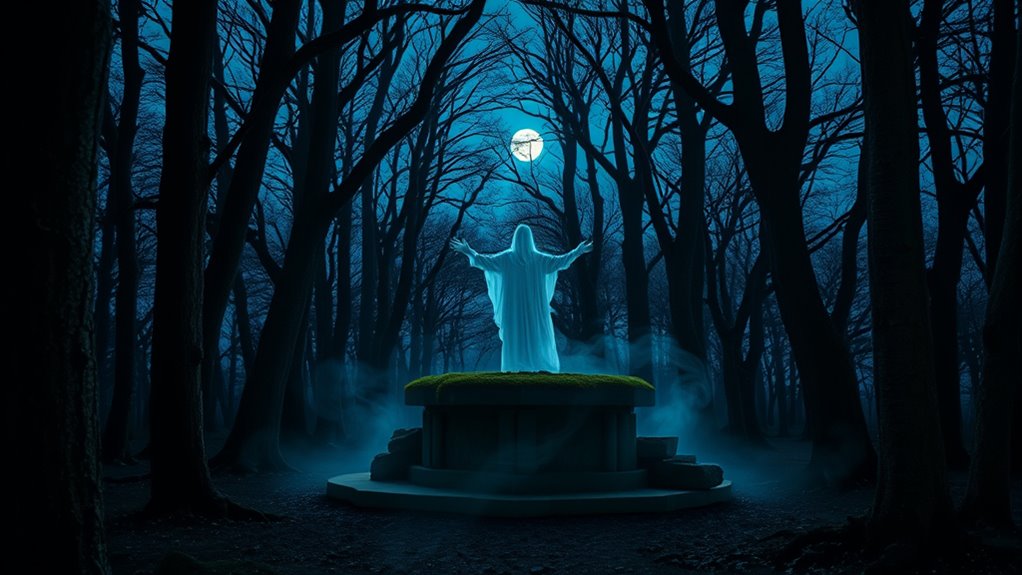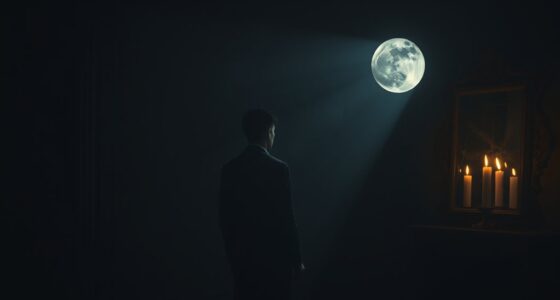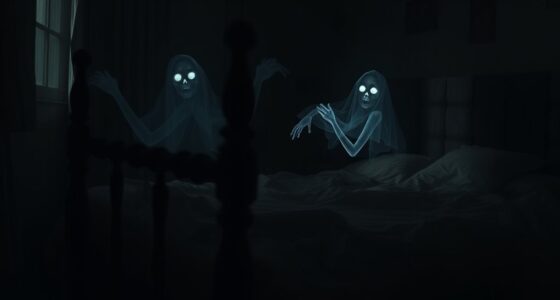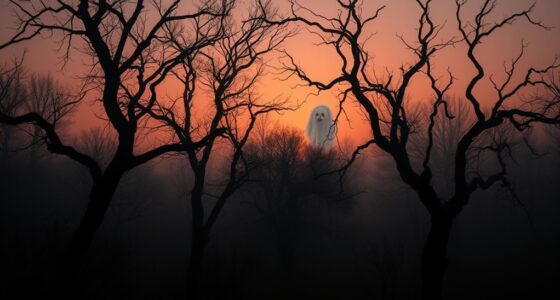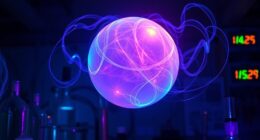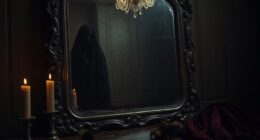If ghosts are real, you might wonder why there’s no solid proof yet. Scientific tools struggle to detect subtle paranormal signals because of interference, environmental noise, and limited technology. Personal stories and cultural beliefs shape what people believe they experience, but these aren’t objective proof. Exploration continues because of human fascination and the desire to understand the unknown. To discover why proof remains elusive, explore the uncovering details ahead.
Key Takeaways
- Paranormal phenomena lack consistent, objective evidence due to technological limitations and environmental interference.
- Current detection tools are insufficiently sensitive and often produce false positives or ambiguous data.
- Human perceptions and psychological biases influence reports, making objective validation challenging.
- Many supposed sightings can be explained by natural causes, stress, or cognitive biases.
- The elusive, unpredictable nature of spirits makes capturing definitive proof extremely difficult.
The Nature of Ghost Sightings and Personal Experiences

Ghost sightings and personal experiences are often the most compelling pieces of evidence people point to when discussing the existence of spirits. Your own personal anecdotes can feel incredibly powerful, especially when shared with others who might have experienced something similar. These stories often hinge on eyewitness credibility—your ability to recount details convincingly can persuade others of authenticity. Many believe that firsthand accounts are more trustworthy than scientific tests, which is why ghost sightings remain so compelling to many. When you share your experience, it’s not just about the event itself but also how you present it—clear, detailed, and sincere. These personal narratives shape the ongoing conversation about whether spirits exist, making eyewitness testimony a cornerstone of the paranormal debate. Additionally, some researchers argue that the benefits of personal testimonies should not be underestimated in understanding the phenomenon. Recognizing the role of anecdotal evidence can help contextualize why personal stories continue to influence beliefs despite the lack of scientific proof. Moreover, understanding the psychological factors behind eyewitness accounts can shed light on why such experiences feel so real to individuals. For example, confirmation bias can lead people to interpret ambiguous stimuli as paranormal encounters, reinforcing their beliefs. Furthermore, the subjective nature of perception means that personal experiences are often shaped by individual expectations and emotions, making them highly persuasive to those who have encountered similar stories.
Scientific Challenges in Detecting Paranormal Activity

While personal anecdotes can be convincing, scientifically confirming supernatural phenomena presents considerable obstacles. Identifying spirits requires objective proof, but occurrences like electromagnetic fluctuations are often inconsistent and tough to duplicate. Quantum entanglement, a sophisticated idea from physics, has been proposed as a potential explanation but remains unverified in this setting. Your attempts are impeded by the absence of standardized measurement instruments and the challenge of differentiating genuine paranormal signals from natural noise. Additionally, cybersecurity vulnerabilities can interfere with data collection and analysis, complicating efforts to establish reliable evidence. Furthermore, the measurement tools currently available lack the sensitivity needed to detect subtle paranormal phenomena reliably. The lack of a scientific consensus on what constitutes definitive proof further hampers progress in this field.
The Limitations of Current Technology

Your current tools often lack the sensitivity needed to detect subtle paranormal signals. Environmental factors like noise and electromagnetic interference can easily distort or hide potential evidence. Additionally, interpreting the data remains challenging, making it tough to distinguish genuine phenomena from false positives. Moreover, the nutritional composition of juices varies widely, which can influence the consistency and reliability of data collected in paranormal investigations. Advances in machine learning algorithms could eventually help analyze complex paranormal data more effectively, especially as these technologies improve in signal processing capabilities. Developing specialized sensors capable of detecting paranormal energies may further enhance investigation accuracy and sensitivity, allowing researchers to pick up on subtle energetic fluctuations that current equipment might miss. As research progresses, developing specialized sensors capable of detecting paranormal energies may further enhance investigation accuracy.
Instrument Sensitivity Limits
Despite advances in technology, current instruments often fall short of detecting subtle phenomena associated with ghosts. Sensor calibration is essential; if devices aren’t precisely calibrated, they miss faint signals or generate false readings. Even with proper calibration, signal amplification remains limited. Many ghost-related phenomena produce extremely weak signals that are difficult to amplify without introducing noise or distortion. This makes it challenging to distinguish real anomalies from background interference. The sensitivity of electromagnetic field meters, thermal cameras, and audio recorders isn’t enough to reliably capture subtle, fleeting events. As a result, the technology simply isn’t advanced enough to detect or prove the existence of ghosts with consistent accuracy. Until sensor calibration and amplification improve, many phenomena will continue to slip through the cracks. Additionally, technological limitations hinder our ability to detect these elusive signals reliably. Progress in sensor technology could eventually overcome these barriers, allowing us to explore these phenomena more thoroughly. Improving detection methods and developing more sophisticated sensors remain crucial steps toward uncovering the truth behind these mysteries.
Environmental Interference Challenges
Environmental interference poses a significant obstacle to detecting ghostly phenomena because external factors constantly disrupt sensor readings. Electromagnetic interference from nearby electronics, power lines, or natural sources can cause false signals or mask genuine ones. Additionally, the challenge of leveraging quantum entanglement for ghost detection remains unresolved, as current technology struggles to maintain coherence over the distances needed. These external influences create noise that makes it difficult to distinguish authentic ghostly signals from background disturbances. Even minor environmental changes can skew data, leading to unreliable results. As a result, the limitations of current technology hinder our ability to gather clear, undeniable evidence of spirits, emphasizing the need for more advanced, interference-resistant equipment in paranormal investigations.
Data Interpretation Difficulties
Current technology often falls short when it comes to accurately interpreting data from paranormal investigations, making it difficult to confirm ghostly activity. You may encounter statistical anomalies that could be misread as evidence, but might just be random fluctuations. Data inconsistencies further complicate analysis, as equipment can produce false positives or miss subtle signals. Without clear, reliable results, it’s hard to distinguish genuine phenomena from noise. Key challenges include:
- Misinterpreting statistical anomalies as proof
- Confusing equipment glitches with paranormal signals
- Overcoming the limitations of sensor sensitivity
- Dealing with data inconsistencies across devices
These issues highlight how current tech struggles to provide definitive proof, leaving much room for doubt and skepticism in ghost investigations.
Cultural and Psychological Factors Influencing Reports

Cultural beliefs and psychological factors play a significant role in shaping the reports of ghost sightings. Your cultural biases influence how you interpret unexplained experiences, often framing them within familiar supernatural narratives. If your society emphasizes spirits or afterlife legends, you’re more likely to interpret strange sensations or sounds as ghost encounters. Psychological projections also come into play; your mind tends to fill gaps in perception with familiar images or fears, especially during stressful or uncertain times. These projections can lead you to perceive a ghost where none exists. In this way, cultural backgrounds and mental processes shape your perception of paranormal activity, making it difficult to distinguish genuine phenomena from constructions of belief and mind. Understanding these factors helps explain why ghost reports are so subjective and varied.
Historical Cases and the Quest for Evidence

Have any of the most famous ghost stories truly stood the test of time because of compelling evidence? Many rely on paranormal folklore and eyewitness accounts, but solid proof remains elusive. Throughout history, cases like the Tower of London or the Myrtles Plantation have intrigued enthusiasts and skeptics alike. These stories fuel ghost hunting efforts, inspiring investigations that seek physical or photographic evidence.
- Historic sightings often lack verifiable documentation.
- Personal testimonies dominate, making proof subjective.
- Modern technology has yet to produce definitive results.
- Some events may be explainable by psychological or environmental factors.
Despite centuries of reports, the quest for concrete evidence continues. These legendary cases highlight human fascination with the supernatural and keep the debate alive about whether ghosts are real or just part of our rich paranormal folklore.
Why the Search for Proof Continues to Fascinate Us

What is it about the possibility of ghosts that continues to captivate us? It’s the mystery that taps into our deep-rooted spiritual beliefs and folklore traditions. We’re drawn to stories of spirits lingering, because they challenge our understanding of life and death. The idea that something might exist beyond our physical world sparks curiosity and hope. Folklore traditions across cultures reinforce this fascination, offering tales that connect us to ancestors or warn us of unseen presences. Searching for proof keeps the conversation alive, driven by a desire to find answers or validate beliefs. This quest isn’t just about evidence; it’s about understanding our place in the universe and embracing the unknown. The mystery of ghosts remains a compelling part of human curiosity.
Frequently Asked Questions
Are There Credible Scientific Studies Confirming the Existence of Ghosts?
You might wonder if credible scientific studies confirm ghosts’ existence. In paranormal research, scientists often approach ghost phenomenology with skepticism, making rigorous evidence hard to find. Many studies lack reproducibility or rely on subjective experiences rather than objective proof. While some experiments suggest unusual phenomena, they don’t conclusively prove ghosts are real. So, the scientific community remains cautious, focusing on exploring phenomena without jumping to supernatural conclusions.
How Do Cultural Beliefs Shape Ghost Sightings Around the World?
You should know that around 45% of people worldwide report ghost sightings, revealing how powerful cultural beliefs are. These beliefs, shaped by cultural rituals and belief systems, influence how you interpret strange experiences. In some cultures, spirits are seen as ancestors or protectors, making sightings more accepted. Your perceptions are deeply influenced by these cultural narratives, which shape how you perceive and report ghost encounters across different societies.
Can Personal Biases Influence the Interpretation of Paranormal Experiences?
Your personal bias can profoundly influence how you interpret paranormal experiences, often leading to perception distortion. If you believe in ghosts, you might see signs where none exist, while skeptics dismiss genuine sensations. Your mindset shapes your expectations and reactions, making it easier to accept or dismiss phenomena based on preconceived notions. Recognizing this bias helps you understand that perception isn’t always an accurate reflection of reality, especially in paranormal encounters.
What Role Do Media and Entertainment Play in Shaping Ghost-Related Perceptions?
Media and entertainment shape your perceptions like a master painter colors a canvas. Horror movies and supernatural documentaries often dramatize ghost stories, making them seem more real and sensational. This influences how you interpret paranormal experiences, blurring the line between fact and fiction. When you see ghostly tales on screen, it fuels your curiosity and belief, even if scientific proof remains elusive. Your mind becomes a playground for supernatural possibilities.
Are There Any Ongoing Efforts to Develop Technology Specifically for Detecting Ghosts?
You might wonder if there are ongoing efforts for ghost detection using paranormal technology. Researchers and tech enthusiasts develop devices aiming to capture ghostly activity, like EMF meters or EVP recorders. While these tools are popular in the paranormal community, scientific validation remains elusive. Still, many believe that advances in ghost detection could someday provide clearer proof, making it an exciting area where technology and mystery intersect.
Conclusion
So, if ghosts are out there, why haven’t we caught them on camera yet? Maybe it’s a case of chasing shadows or the mind playing tricks. The truth is, the search for proof is like looking for a needle in a haystack—challenging and often frustrating. But that doesn’t mean the mystery isn’t worth exploring. Sometimes, the more you seek, the more you realize some questions are better left unanswered, at least for now.
